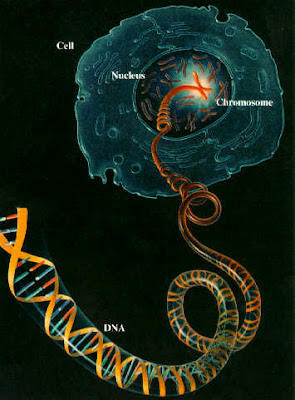Saturday, November 27, 2010
DNA and NUCLEAR DIVISION
These 2 double strands form the 2 sections of chromosomes (called chromatids) that are easily seen when a cell is about to divide. In mitosis the chromosomes are then evenly distributed to different ends of the cell, ready to be incorporated into 2 new cells when the cell itself divides.
animation - mitosis
Mitosis
For clarity, only 2 pairs of chromosomes are shown in these diagrams
mit1 mit2 mit3 mit4 mit5
In mitosis, the nucleus divides once to produce 2 nuclei, which then form into 2 genetically identical "ordinary" cells, containing the same number of chromosomes as the original cell (46 in human cells)
Because of the reliability of the replication of DNA and mitosis, offspring resulting from asexual reproduction do not usually vary at all, which is the basis of taking cuttings, etc. Similarly, multicellular organisms consists of a harmonious population of identical cells derived from one initial cell, the fertilised egg or zygote. However, in some cases (about 1 in a million) there may be an error in the copying process; an incorrect copy of the DNA will be passed on to any (body) cells produced following cell division. This may be the cause of different types of cancer, which are associated with exposure to radiation or chemicals and viruses which damage DNA.
Subscribe to:
Post Comments (Atom)

No comments:
Post a Comment